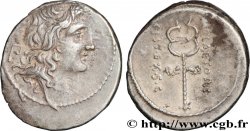Live auction - brm_888501 - PLAETORIA Denier
You must signin and be an approved bidder to bid, LOGIN TO BID. Accounts are subject to approval and the approval process takes place within 48 hours. Do not wait until the day a sale closes to register. Clicking on "BID" constitutes acceptance of the terms of use of cgb.fr private live auctions.
Bids must be placed in whole Euro amounts only. The sale will start closing at the time stated on the item description; any bids received at the site after the closing time will not be executed. Transmission times may vary and bids could be rejected if you wait until the last second. For further information check the Live auction FAQ
All winning bids are subject to a 18% buyer’s fee.
All winning bids are subject to a 18% buyer’s fee.
| Estimate : | 400 € |
| Price : | 200 € |
| Maximum bid : | 201 € |
| End of the sale : | 23 January 2024 14:49:27 |
| bidders : | 1 bidder |
Type : Denier
Date: 67 AC.
Mint name / Town : Roma
Metal : silver
Millesimal fineness : 950 ‰
Diameter : 18 mm
Orientation dies : 3 h.
Weight : 3,88 g.
Rarity : R1
Coments on the condition:
Très bel exemplaire sur un flan légèrement décentré. Superbe revers, finement détaillé. Buste bien venu à la frappe. Patine grise de collection avec de légers reflets dorés
Catalogue references :
Obverse
Obverse legend : CESTIANVS/ S.C.
Obverse description : Buste ailé, casqué, lauré, couronné d'épis et drapé de Vacuna à droite avec une corne d'abondance ; le tout entouré de la stemma, “corona infula”.
Obverse translation : “Cestianus/ Senatus Consulto”, (Cestianus/ avec l’accord du Sénat).
Reverse
Reverse legend : M. PLAETORIVS. M. F. AED - CVR.
Reverse description : Aigle debout à droite sur un foudre, détournant la tête à gauche ; le tout entouré de la stemma “corona infula”, (bandelette de laine).
Reverse translation : “Marcus Plætorius Marci Filius Ædilis Curilis”, (Marcus Plætorius fils de Marc Édile curule).
Commentary
Pour ce type, M. Crawford a relevé une estimation de 58 coins de droit et de 64 coins de revers. Ce denier aurait inspiré, pour le droit, les petites monnaies en bronze et en argent EPAD, données aux Arvernes (LT. 3900).








 Report a mistake
Report a mistake Print the page
Print the page Share my selection
Share my selection Ask a question
Ask a question Consign / sell
Consign / sell
 Full data
Full data















